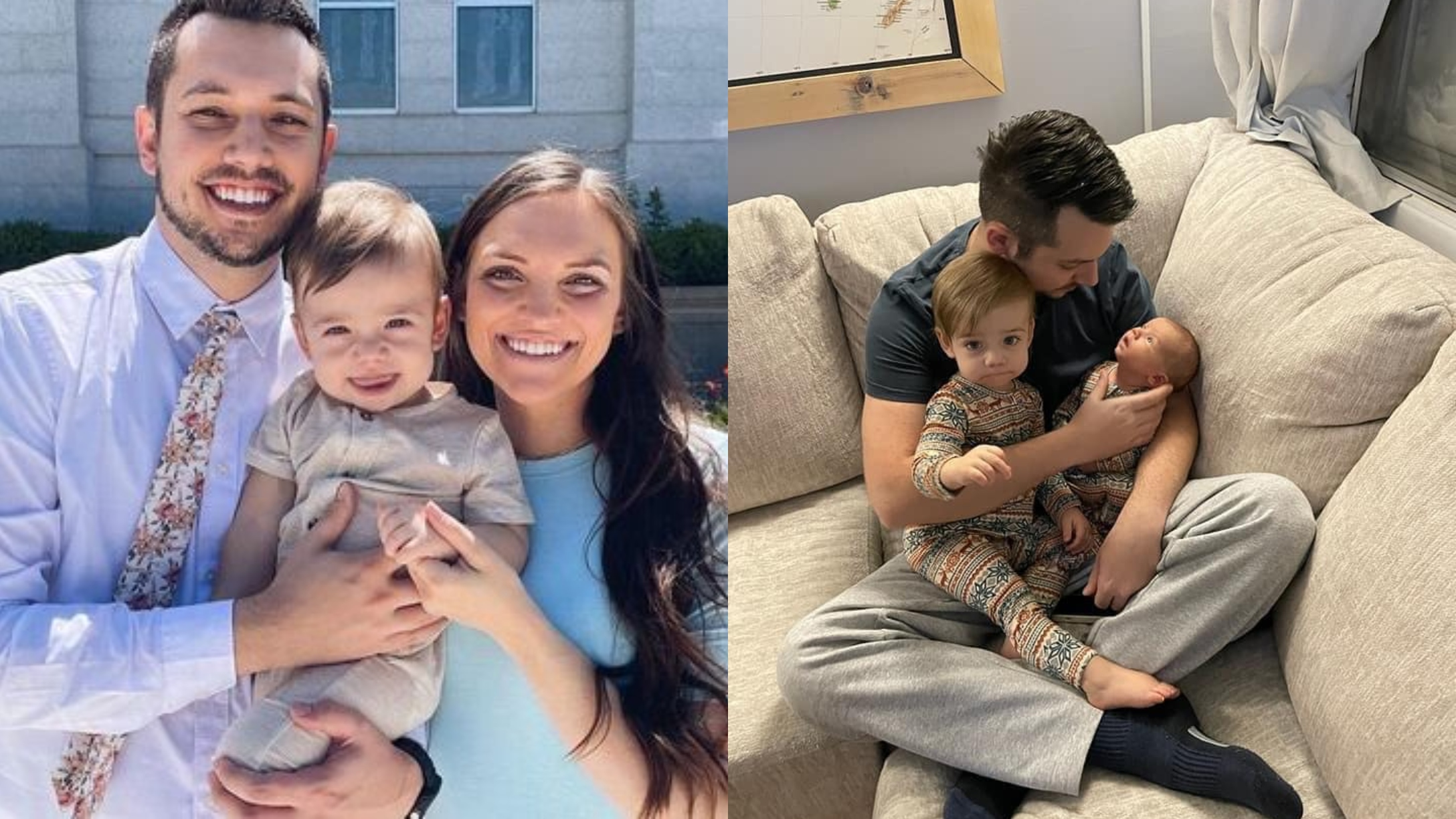
A doctor, father, and husband is now a widower, raising two boys alone as he tries to put his life back together after the unexpected death of his wife. Jared Wilson, who is sharing his story now, brought his wife to the hospital to deliver their second child, son Gabriel, on December 12.
Sadly, Caitlyn Wilson suffered severe complications after an emergency C-section, and Jared only brought one family member home from the Buffalo, New York, hospital where his second son was born.
More from CafeMom: Pregnant Bride Dies From a Stroke on the Way to Wedding — But Her Unborn Baby Is Saved
Gabriel was positioned oddly in Caitlyn's womb.
Caitlyn, 27, was scheduled to be induced, People reported. Once Jared dropped her off at the hospital, he returned home to take care of the couple’s 1-year-old son, Lincoln. Later that night, Jared, who works as an anesthesiologist resident at the same hospital, returned to be by Caitlyn’s side. Everything “seemed to be going really, really well,” Jared said.
Caitlyn had gotten an epidural at 1 a.m., and a resident came to break her water shortly after that. When the resident broke Caitlyn’s water, they discovered that Gabriel’s positioning presented a problem. “His arm was somewhat above his face, in a raised position, and directly behind him was the umbilical cord,” Jared explained.
In the resident’s attempts to reposition Gabriel, Jared said the resident “swooped” his arm or umbilical cord. The movement sent Gabriel’s arm into the birth canal and “the cord [was] getting pinched between his neck and his head and the wall as the fluid drained out.” This positioning leads to a condition called uterine cord prolapse, causing the baby to potentially suffocate.
Thankfully, a chief resident came in, “put her hand basically all the way up to Cait’s uterus and lifted Gabriel inside the birth canal off of his own cord and activated an emergency C-section,” he explained.
By 2:02 a.m., Caitlyn was being taken into the OR. Jared texted both sets of parents with an update, and the procedure went quickly. At 2:17 the surgeons had photos of Gabriel, time-stamped at 2:12. “So in a matter of 10 minutes, they wheeled her down to the OR, opened her up and had a baby out,” he said.
More from CafeMom: A Common Delivery Room Mistake May Have Cost This Mom Her Limbs
Jared says Caitlyn's conditions were 'perfectly hidden by a perfect storm of aspiration, emergency surgery, and pregnancy.'
After Gabriel was delivered, that’s when things took a turn for the worst. Caitlyn was transferred to general anesthesia and intubated in the operating room.
"One of the risks of general anesthesia always is significant aspiration of stomach fluids and contents to go back down into her lungs. That's increased for trauma in emergency situations, particularly in a pregnant woman who's been drinking water all day and has a big giant baby pushing up on her stomach and her lungs," Jared told People. “When they intubated Caitlyn, she had cups and cups of fluid, both water and stomach acid, come up and go down into her mouth. As they suctioned it out and placed the tube, the concern was how much of that ended up in her lungs."
After two hours, Caitlyn was wheeled back into the room. She was still on a small amount of oxygen.
“Caitlyn was coughing really, really hard.” To make matters worse, Jared explained that before the birth, Caitlyn had a mild case of bronchitis and her airways were still inflamed and reactive. She was coughing but couldn’t do so strongly enough because her “stomach felt like it was going to tear open.”
Still, Jared said she was able to get a lot of fluid out. He said that Gabriel was safe and healthy and it appeared that Caitlyn was too.
“She looked like she was probably going to struggle for a bit, and she started antibiotics to make Sure she didn’t get any kind of pneumonia from the fluid,” he said. He assumed that at 27 and healthy, Caitlyn would be able to bounce back quickly.
Over the next 10 days, Jared said complications arose that were “perfectly hidden by a perfect storm of aspiration, emergency surgery and pregnancy.”
“She was in obvious significant pain and her heart rate was high,” he explained to People. “She had swelling in her lower legs. She had this massive hormonal shift with a C-section and milk letdown and a baby. And of course, the stress of being in a hospital and being on oxygen and hooked up to these monitors and just wanting to go home with the baby.”
Eventually, Caitlyn got tired and asked for assistance breathing.
Eventually, Caitlyn required more oxygen and was transferred to the intensive care unit. At the same time, Jared was able to bring Gabriel home. "Every day it was kind of the same. She would slowly progressively need a little bit more oxygen, but she was awake, she was talking to us and the pain was well controlled on the medications," he said.
On December 21, Caitlyn was intubated because of inflammation in her lungs. "She wanted to have a little bit of rest and allow us to place a tube and have the machine to do the breathing for her," Jared recalled. "She was tired of running this marathon and I could see it in her."
The intubation marked a turning point in Caitlyn’s decline. “Immediately things went wrong,” Jared said. “Up to this point, the only medications Caitlyn had been on were some low-dose pain meds and stuff for acid reflux and constipation. She was the healthiest person in the ICU.
"The minute we intubated and she desaturated, we could not keep Caitlyn up. The machine is designed perfectly to match human respiratory function and it couldn't do it," Jared continued. "At the exact same time, labs, which had never really returned abnormal in nine days, suddenly started to show a double white count. She went from 10 to 40 in under eight hours, which is massive in the scope of things."
Caitlyn’s blood pressure dropped. All of the fluid that had been a part of her treatment started to spread to other tissues and muscles.
"The more fluid we put into her, if it starts to leak it can leak into the lungs, which is exactly what we don't want," he explained to the magazine. "But she's dehydrated, so we can't not give her fluid. Her blood pressure's low and she's lost a lot of blood, so we have to give fluids and blood."
Medical personnel left as he held Caitlyn. 'And that was it,' Jared recalls.
Then doctors found that Caitlyn had two blood clots in her legs and evidence that another one may have traveled to her heart. “Ultrasounds showed that her heart was having obstructive shock,” Jared said.
Caitlyn also was in septic shock, which requires fluids for treatment. She needed blood thinners for the blood clots. But after the C-section, where she had already lost a lot of blood, that was dangerous.
“Up until the 21st, Caitlyn had been a healthy, talking, pale and tired, strong, amazing woman, and she tired out as anybody would. But the second she allowed others to help her and to take a rest from her own fight, 12 hours after we intubated, she coded for the first time," Jared shared.
They got her back but started to see signs of organ damage as a result of the lack of oxygen, her low blood pressure, and the sepsis.
"We were trying to do literally everything we could for this 27-year-old and it wasn't working. The last ditch effort was to put her on dialysis to try to clean the acid and the white blood cells to help provide healthy blood to all of her organs," Jared explained. "But in doing so, you take fluid away from the body and in septic shock, again, you need fluid."
The next day, Caitlyn coded a second time. When Jared returned to her room, she had been in code for three minutes. "They were just about to push more epinephrine and switch people doing compressions, and I just had to call the code," Jared recalled.
Because he worked at the hospital, Jared was allowed to stay with Caitlyn every night. "To be there at that time, and to be wearing the same uniform that a bunch of other doctors were, I walked into the room as they were providing compressions to Caitlyn and I asked them to stop, and I called the code," he said, getting emotional. "They turned off the machines, and then they left as I held Caitlyn. And that was it."
'The boys will know their mom,' Jared says.
After Caitlyn’s death, Jared and his sons flew to Utah to stay with Caitlyn’s parents until they had her funeral on January 15. Jared’s own parents sold their three houses and two cars, liquidating everything to move in with him in Buffalo.
“They started this process the day I told them Caitlyn might not make it,” he said. "I hadn't even contemplated the idea of how I was supposed to work a 75-hour work week and make as little as a resident makes and take care of these two boys.”
Despite the devastating result, Jared does not blame the hospital for what happened to his wife.
"Cait had the gold standard of tests, the gold standard of care. She required no real treatment besides oxygen for days, and then it just went south so quickly,” he said, adding, "if I didn't know all of those things, I think there would be more to grieve in not understanding how this happened."
Now, as he attempts to rebuild his life and raise his sons, Jared said he takes comfort in the fact that he spent three and a half years with this amazing woman.
"It's enough that it will last a lifetime, because as difficult as it will be to raise these boys as a single dad and a doctor, and they won't know their mom the way that they should, and they won't know of her love for them the way that they should, I'll have to work on how to do it," he shared.
"But true love, as sappy and as fairytale and cheesy as it sounds, is real, and it absolutely transcends any boundary of death, life, distance, or mom, that those three years are enough for me to live the rest of my life on. And they're enough that the boys will know of their mom."
The Wilson family’s GoFundMe page is still accepting donations.




